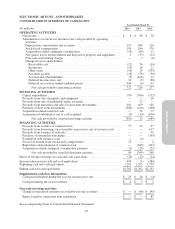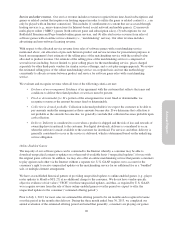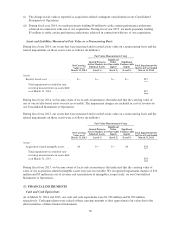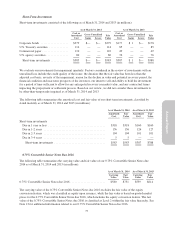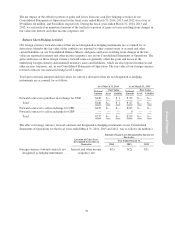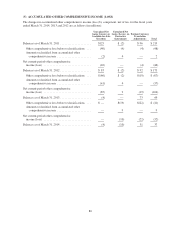Electronic Arts 2014 Annual Report Download - page 140
Download and view the complete annual report
Please find page 140 of the 2014 Electronic Arts annual report below. You can navigate through the pages in the report by either clicking on the pages listed below, or by using the keyword search tool below to find specific information within the annual report.online over a larger period of time. Based on this, we concluded that for physical software sales made after
June 30, 2013, the estimated offering period should be increased to nine months, resulting in revenue being
recognized over a longer period of time. The estimated offering period for digitally distributed software games is
six months.
Other Multiple-Element Arrangements
In some of our multiple-element arrangements, we sell tangible products with software and/or software-related
offerings. These tangible products are generally either peripherals or ancillary collectors’ items, such as figurines
and comic books. Revenue for these arrangements is allocated to each separate unit of accounting for each
deliverable using the relative selling prices of each deliverable in the arrangement based on the selling price
hierarchy described below. If the arrangement contains more than one software deliverable, the arrangement
consideration is allocated to the software deliverables as a group and then allocated to each software deliverable
in accordance with ASC 985-605.
We determine the selling price for a tangible product deliverable based on the following selling price hierarchy:
VSOE (i.e., the price we charge when the tangible product is sold separately) if available, third-party evidence
(“TPE”) of fair value (i.e., the price charged by others for similar tangible products) if VSOE is not available, or
our best estimate of selling price (“BESP”) if neither VSOE nor TPE is available. In accordance with ASC 605,
provided the other three revenue recognition criteria other than delivery have been met, we recognize revenue
upon delivery to the customer as we have no further obligations.
Principal Agent Considerations
In accordance with ASC 605-45, Revenue Recognition: Principal Agent Considerations, we evaluate sales of our
interactive software games via third party storefronts, including digital storefronts such as Xbox Live
Marketplace, Sony PSN, Apple AppStore, Google Play) in order to determine whether or not we are acting as the
principal or as an agent, which we consider in determining if revenue should be reported gross or net of fees
retained by the storefront. Key indicators that we evaluate in determining gross versus net treatment include but
are not limited to the following:
• The party responsible for delivery/fulfillment of the product or service to the end consumer
• The party responsible for the billing, collection of fees and refunds to the consumer
• The storefront and Terms of Sale that govern the consumer’s purchase of the product or service
• The party that sets the pricing with the consumer and has credit risk
Based on the evaluation of the above indicators, we have determined that we are generally acting as an agent and
are not considered the primary obligor to consumers for our interactive software games distributed through third
party digital storefronts. We therefore recognize revenue related to these arrangements on a net basis.
Sales Returns and Allowances and Bad Debt Reserves
We reduce revenue primarily for estimated future returns and price protection which may occur with our
distributors and retailers (“channel partners”). Price protection represents our practice to provide our channel
partners with a credit allowance to lower their wholesale price on a particular product in the channel. The amount
of the price protection is generally the difference between the old wholesale price and the new reduced wholesale
price. In certain countries for our PC and console packaged goods software products, we also have a practice of
allowing channel partners to return older software products in the channel in exchange for a credit allowance. As
a general practice, we do not give cash refunds.
Taxes Collected from Customers and Remitted to Governmental Authorities
Taxes assessed by a government authority that are both imposed on and concurrent with specific revenue
transactions between us and our customers are presented on a net basis in our Consolidated Statements of
Operations.
70







